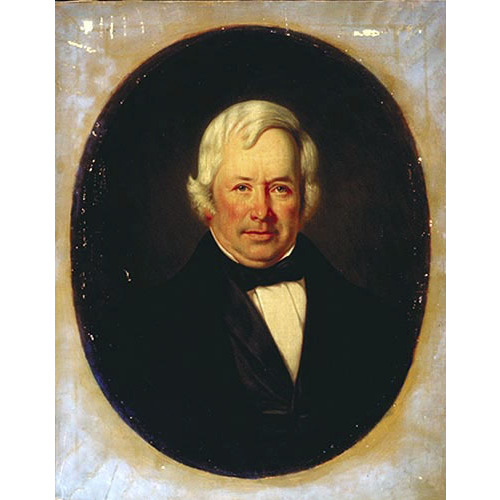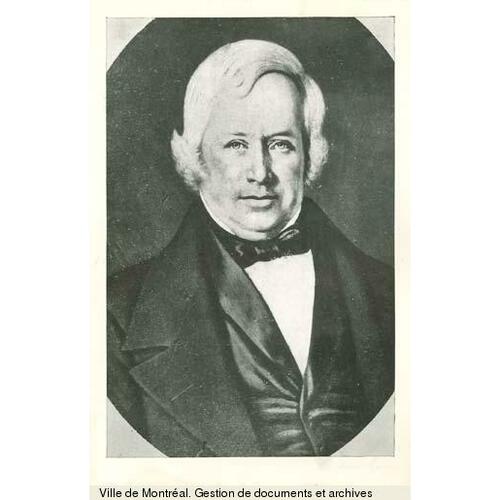
Source: Link
HAMEL, ANDRÉ-RÉMI, lawyer, office holder, and author; b. 22 Oct. 1788 at Quebec, son of Charles Hamel, a tinsmith, and Marie Bedouin; d. 24 March 1840 in Leeds, Lower Canada.
André-Rémi Hamel did his classical studies at the Petit Séminaire de Québec in the period 1804–12. In 1813 he began articling under Quebec lawyer Louis Plamondon*. He was called to the bar on 20 April 1818 and went into practice at Quebec. There, on 23 June of the following year, he married Marie-Adélaïde Roy, an aunt of Pierre-Joseph-Olivier Chauveau*. Among those he later took in as articling students were Chauveau and René-Édouard Caron*, who became respectively premier and lieutenant governor of Quebec.
Although he had little interest in politics, in December 1827 Hamel, along with Amable Berthelot, Hector-Simon Huot, Louis Lagueux*, and John Neilson, joined a 35-member committee headed by Joseph-Rémi Vallières de Saint-Réal and appointed at a meeting of voters from the town of Quebec. The committee was established to draw up and submit to the king and the British parliament a petition listing grievances about the composition of the Legislative Council and its subordination to the executive authority, the exorbitant expenditures resulting from sinecures, the ineffectiveness of assembly grants in furthering education, the allocation of public revenues without the assembly’s prior consent, the mismanagement of public lands, and the attempts by the British parliament to change the constitution without the knowledge of the province’s residents.
This petition, as well as another more vehement one sent by a committee from the Montreal region, was submitted to London. A House of Commons committee studied the questions raised and published a report acknowledging the validity of the Canadians’ grievances. Its recommendations were not acted upon, however, and most of the complaints set out in 1828 were reiterated in the famous 92 Resolutions of 1834 [see Elzéar Bédard].
In 1831, while still in practice, Hamel published, under the pseudonym Un Ami de l’Ordre, La question des fabriques, which had first appeared as extracts in the Quebec Gazette a few months earlier at the time the assembly was studying a bill introduced by Louis Bourdages* to permit the presence of property owners at the election of churchwardens and the rendering of accounts by the fabriques. The assembly consulted numerous parish priests and, with one or two exceptions, the clergy as a whole was opposed to the bill. In his pamphlet Hamel cited various conciliar laws, edicts, and canons in support of those who were against the proposal. His argument was based on the fact that the assets and income of a fabrique, consisting of free gifts, pew rentals, and fees for services, belonged exclusively to the church. Since administration of private assets did not come under the state, there was no requirement for churchwardens to be elected democratically or for accounts to be rendered in public. After making some amendments, the assembly adopted the bill, but it was rejected by the Legislative Council.
On 11 July 1832 Hamel was appointed advocate general of Lower Canada, replacing George Vanfelson* who had resigned. He acquired a certain reputation while holding this office. On 18 Feb. 1834 Hamel was summoned before the assembly because, in his capacity as advocate general and without the authorization of the house, he had given the governor, Lord Aylmer [Whitworth-Aylmer], a legal opinion on the by-election of December 1833 in Stanstead riding. Hamel had confirmed the returning officer’s decision to declare Wright Chamberlin elected, even though Marcus Child* had apparently received 70 votes more. The house considered his giving an opinion in this matter an infringement of its rights and privileges and the speaker, Louis-Joseph Papineau*, publicly reprimanded Hamel. It is important to bear in mind that the rebuke was delivered at the time when the assembly was debating the 92 Resolutions, which included a denunciation of direct interference by the governor and legislative councillors in the election of the people’s representatives and particularly in the choice of returning officers. In the event, the next day the assembly declared Child officially elected.
Le Canadien on 21 Feb. 1834 none the less stressed the courageous action taken by Hamel, who had chosen to appear before the assembly and face up to his responsibilities. Six days later the members of the Montreal bar met to protest the reprimand. They regarded this incident as a direct attack on the independence of the bar, which was necessary for the protection of the individual and the defence of citizens’ rights. Historian Robert Christie* considered that Hamel’s opinion “was in accordance with the law, and no doubt conscientious.”
On 2 May 1839 Hamel was named a commissioner of the Court of Requests in the district of Quebec, and on 14 May he was made a qc. He discharged his duties until he succumbed to a stroke in Leeds, near Quebec, on 24 March 1840, at 51 years of age. His remains were taken to Quebec and buried three days later in the crypt of Notre-Dame cathedral. In its obituary the Quebec Gazette on 28 March paid homage to Hamel: “Gifted with outstanding talents that were constantly and almost exclusively used in the study of law, Mr Hamel was one of the most distinguished lawyers in [his province]: his activity and his zeal, which led him to observe scrupulously all the requirements of a legal system reputed to be unworkable, made him, during the short space of time that he administered justice, an exemplary magistrate.”
André-Rémi Hamel is the author of La question des fabriques (Québec, 1831), published under the pseudonym Un Ami de l’Ordre.
ANQ-Q, CE1-1, 23 oct. 1788, 23 juin 1819, 27 mars 1840. ASQ, Fichier des anciens. PAC, MG 30, D1, 15: 14–16; RG 4, B8: 7048–51; RG 68, General index, 1651–1841. Le Canadien, 19, 21, 24 févr. 1834. La Gazette de Québec, 19–20 févr. 1834, 28 mars 1840. F.–J. Audet, “Commissions d’avocats,” BRH, 39: 581; “Conseils du roi,” BRH, 41 (1935): 609–10; “Conseils du roi dans le Bas-Canada,” BRH, 31 (1925): 57; “Procureurs généraux de la province de Québec (1764–1791),” BRH, 39 (1933): 276–77. Philéas Gagnon, Essai de bibliographie canadienne . . . (2v., Québec et Montréal, 1895–1913; réimpr. Dubuque, Iowa, [1962]). H. J. Morgan, Bibliotheca Canadensis; Sketches of celebrated Canadians, 472. P.-G. Roy, Les avocats de !a région de Québec; Fils de Québec, 3: 42–43; Les juges de la prov. de Québec. Tanguay, Dictionnaire, 4: 451–52. Bernard Vinet, Pseudonymes québécois (Québec, 1974), 244. Buchanan, Bench and bar of L.C., 55, 89–90. Chapais, Cours d’hist. du Canada, 3: 187–202; 4: 16–25. N.-E. Dionne, Les trois comédies du “statu quo,” 1834 (Québec, 1909), 40–56. Edmond Lareau, Histoire de la littérature canadienne (Montréal, 1874). J.-E. Roy, Hist. de Lauzon, 5: 285–341. Paul Bernier, “Le droit paroissial avant et depuis Mignault,” La Rev. du notariat (Québec), 46 (1943–44): 175–99. “Les disparus; l’honorable André-Rémi Hamel,” BRH, 31 (1925): 548. “Le docteur John Buchanan,” BRH, 17 (1911): 102.
Cite This Article
Claude Vachon, “HAMEL, ANDRÉ-RÉMI,” in Dictionary of Canadian Biography, vol. 7, University of Toronto/Université Laval, 2003–, accessed January 6, 2026, https://www.biographi.ca/en/bio/hamel_andre_remi_7E.html.
The citation above shows the format for footnotes and endnotes according to the Chicago manual of style (16th edition). Information to be used in other citation formats:
| Permalink: | https://www.biographi.ca/en/bio/hamel_andre_remi_7E.html |
| Author of Article: | Claude Vachon |
| Title of Article: | HAMEL, ANDRÉ-RÉMI |
| Publication Name: | Dictionary of Canadian Biography, vol. 7 |
| Publisher: | University of Toronto/Université Laval |
| Year of publication: | 1988 |
| Year of revision: | 1988 |
| Access Date: | January 6, 2026 |




